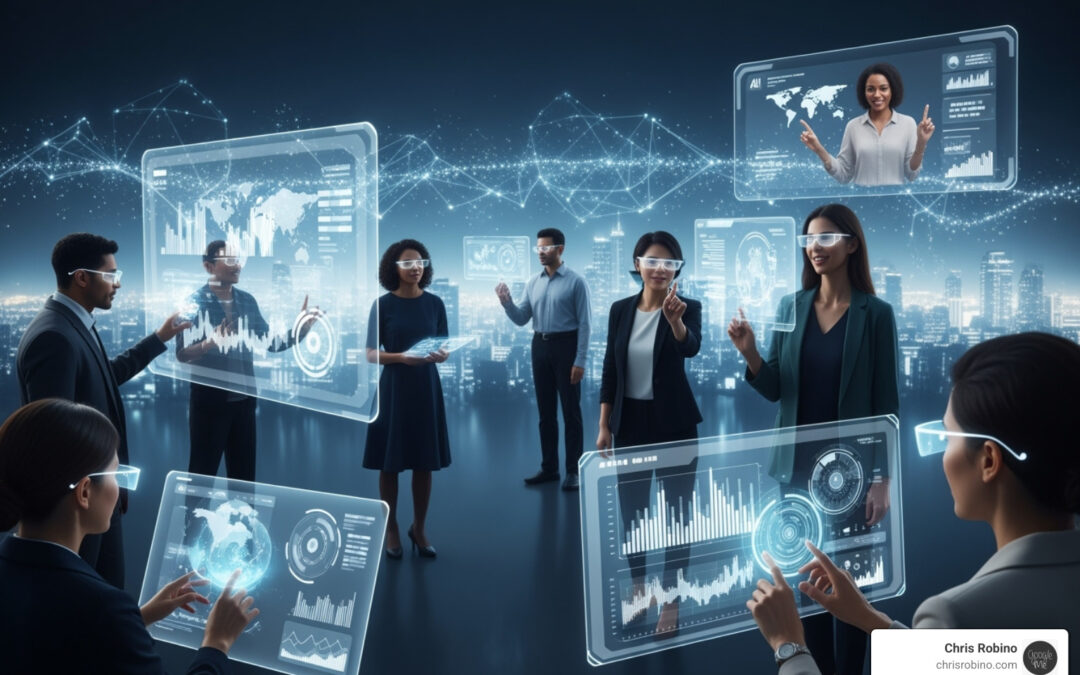Why the Future of Communication is Changing Everything We Know
The Future of communication is no longer a distant concept; it’s happening now, reshaping how we connect, collaborate, and understand each other. Here are the key trends and technologies driving this change:
Key Communication Technologies Shaping the Future:
- AI-powered personalization – Smart systems that adapt messages to individual preferences
- Real-time language translation – Breaking down language barriers instantly
- Immersive AR/VR experiences – Virtual meetings that feel like being in the same room
- Brain-computer interfaces – Direct thought transmission (still in early development)
- 5G and satellite connectivity – Ultra-fast, global communication networks
- IoT integration – Devices that communicate automatically with each other
The communication tools we use today were science fiction 50 years ago. From the printing press to the internet, each technological leap has redefined how we share information. Now, artificial intelligence represents the next great change in human communication.
Eight out of ten journalists worldwide expect an increase in AI use in their newsrooms, while less than 20% of operators have deployed full 5G capabilities, showing we’re in the early stages of this revolution. The changes ahead will impact everything from how businesses serve customers to how we maintain personal relationships.
I’m Chris Robino, and as a Digital Strategy Leader and AI Expert with over two decades of experience, I’ve helped organizations steer the complexities of emerging technologies and their impact on the Future of communication. Through my work, I’ve seen how AI-driven systems and intelligent search solutions are already changing how we connect and collaborate.
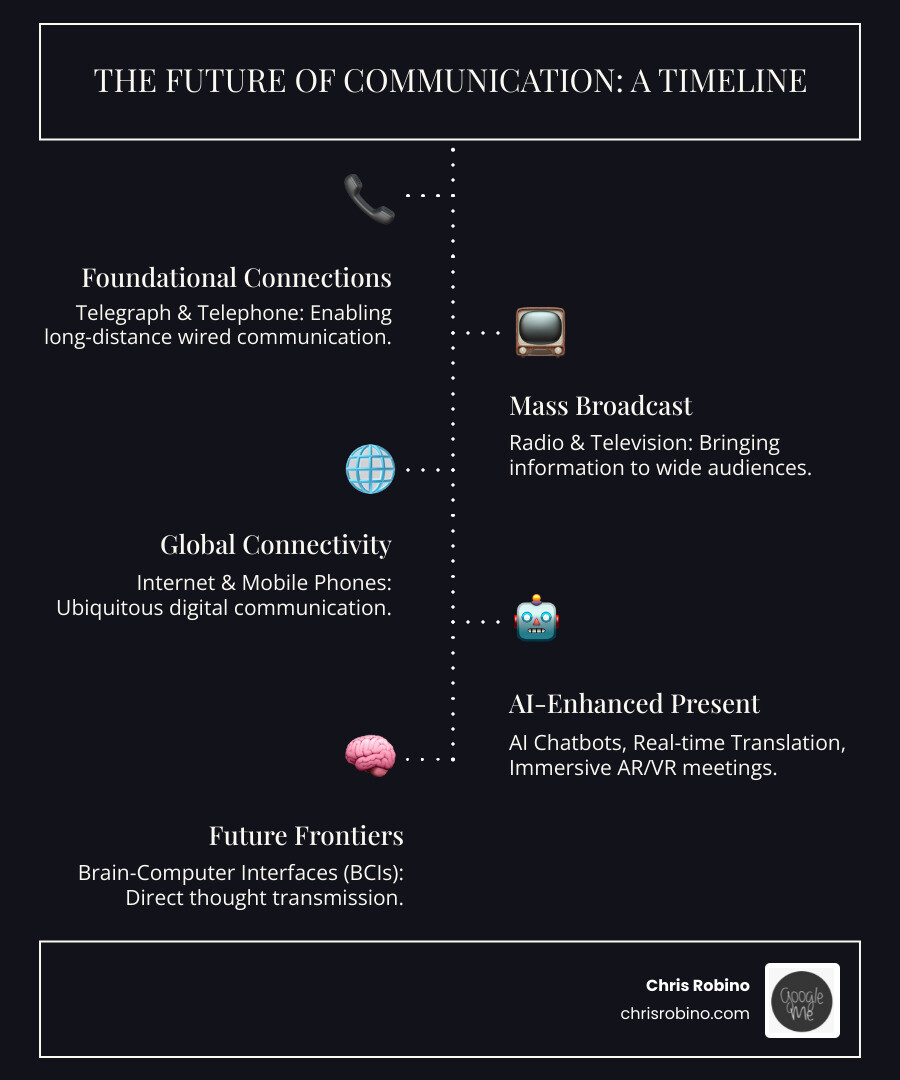
The AI-Powered Present: How Technology is Already Changing How We Connect
The communication landscape is shifting, driven by relentless innovation. What seemed futuristic is now commonplace, and the pace of change is accelerating. We’re witnessing a profound evolution in how we interact, both personally and professionally.
The Evolution of Personal Devices and Networks
Smartphones have become the central hub of our digital lives, pushing basic cell phones into obsolescence. The introduction of user-friendly operating systems and iconic devices propelled smartphones into the mass market, enabling communication far beyond simple calls. As early as 2010, the appearance of the first 4G smartphones for major U.S. carriers signaled the start of this trend.
The internet plays an increasingly foundational role. Voice over Internet Protocol (VoIP) allows calls over an internet service, powering many popular communication applications. This connectivity is about to get even faster.
While less than 20% of operators have fully deployed 5G Standalone (SA), its impact is undeniable. 5G Fixed Wireless Access (FWA) is already providing alternate broadband access, especially in rural communities. As 5G matures, the industry looks ahead to 6G, which promises wider bandwidths and lower latency for immersive experiences like holographic communication.
The integration of the Internet of Things (IoT) into our communication systems is also growing. Imagine a smart home where devices communicate seamlessly or a workplace where meeting rooms automatically adjust based on occupancy. IoT integration creates intelligent environments, offering real-time analytics and predictive maintenance alerts. This interconnected web of devices improves communication with our surroundings and automates routine tasks, improving efficiency and safety.
Underpinning this evolution is hybrid-cloud infrastructure. This approach lets businesses blend on-premise infrastructure with public cloud services, offering scalability, flexibility, and robust disaster recovery solutions. This pathway allows gradual IT transitions without massive disruptions, ensuring communication systems remain agile. You can learn more about how we leverage these advancements in Cloud Solutions for Media.
Furthermore, satellite connectivity is bridging geographical gaps. Telcos are adopting satellite solutions to extend network reach and reduce costs, helping bridge the digital divide for underserved populations. This ensures remote areas can participate in the global conversation. As we look to the future, sustainability and energy efficiency are gaining prominence in the post-5G era. Our commitment to Sustainable Tech Solutions is integral to this development.
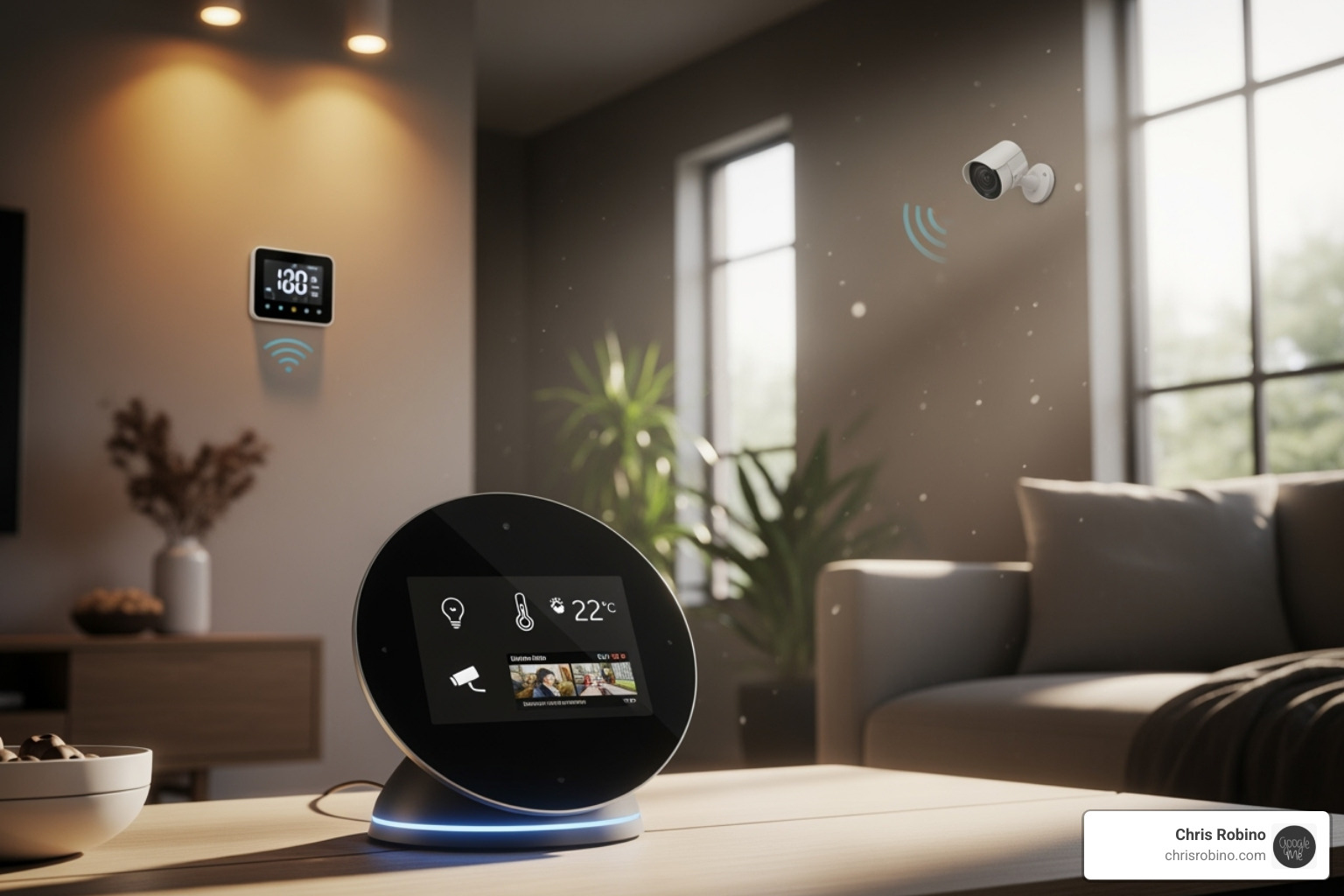
AI’s Integration into Business and Customer Service
Artificial intelligence is a fundamental force changing how businesses communicate. It’s revolutionizing how organizations handle communications, creating seamless interactions that improve employee productivity and customer experience.
One of the most significant ways AI is changing communication is through personalization. AI tools analyze vast data on user behavior and preferences to create highly targeted communication strategies. This ranges from crafting resonant ad campaigns to anticipating customer needs in a service interaction. AI’s ability to facilitate personalization is changing communication in profound ways.
AI also smooths daily workflows through intelligent routing, automated scheduling, and calendar management. Real-time speech analytics provide insights into conversations, helping businesses understand customer sentiment and improve service quality.
Perhaps most visibly, AI chatbots are changing how businesses communicate with customers. Offering 24/7 support, these chatbots handle basic inquiries, troubleshoot problems, and complete simple transactions without human intervention. This frees human agents to focus on complex issues, improving efficiency and customer experience. They can answer questions about orders, products, and services, leading to quicker resolutions and happier customers. We’re actively developing AI-Driven Business Solutions to harness these capabilities.
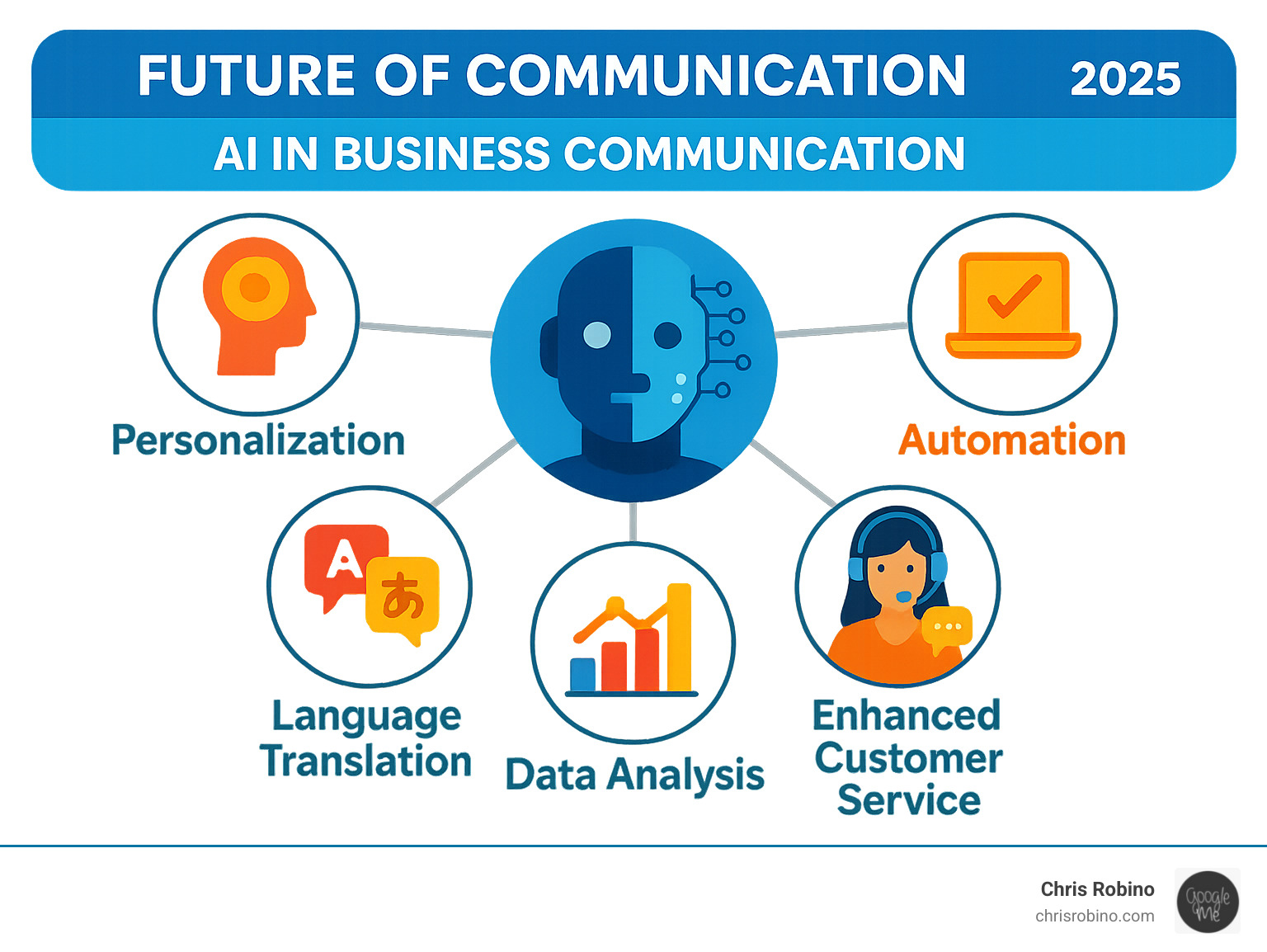
Bridging Gaps with Immersive Tech and Real-Time Translation
Beyond efficiency gains, technology is making communication richer and more accessible. Immersive technologies like augmented reality (AR) are changing how we interact and share information. In an AR system, we view the world through a technological overlay, like a smartphone or specialized glasses. Imagine standing before a restaurant and, through an AR system, instantly reading reviews or viewing specials. AR applications in communication could include:
- Interactive Product Demonstrations: Overlaying digital information onto physical products for customers.
- Remote Assistance: Guiding technicians through complex repairs with visual instructions overlaid on real-world objects.
- Improved Navigation: Displaying directions and points of interest directly on our field of view.
- Immersive Learning: Creating interactive educational experiences.
- Personalized Information Overlays: Seeing real-time data about people or places as you meet them (privacy concerns notwithstanding!).
Advanced video conferencing is evolving beyond simple calls to create more immersive virtual meetings. Features like virtual whiteboards, real-time document collaboration, and 3D environments make remote collaboration feel more like in-person interaction. These advancements allow us to connect with colleagues and clients globally with unprecedented clarity. Our work in AV Tech Media Solutions explores these frontiers.
One of the most exciting developments is real-time language translation. AI can bridge the communication gap between languages, revolutionizing how we interact across cultures. Real-time translation tools, available as smartphone apps and web services, enable seamless conversations during a worldwide conference or an international trip. Machine translation services are becoming more sophisticated, translating complex documents with greater accuracy. This enables unprecedented global collaboration, allowing researchers and businesses to share knowledge more efficiently.
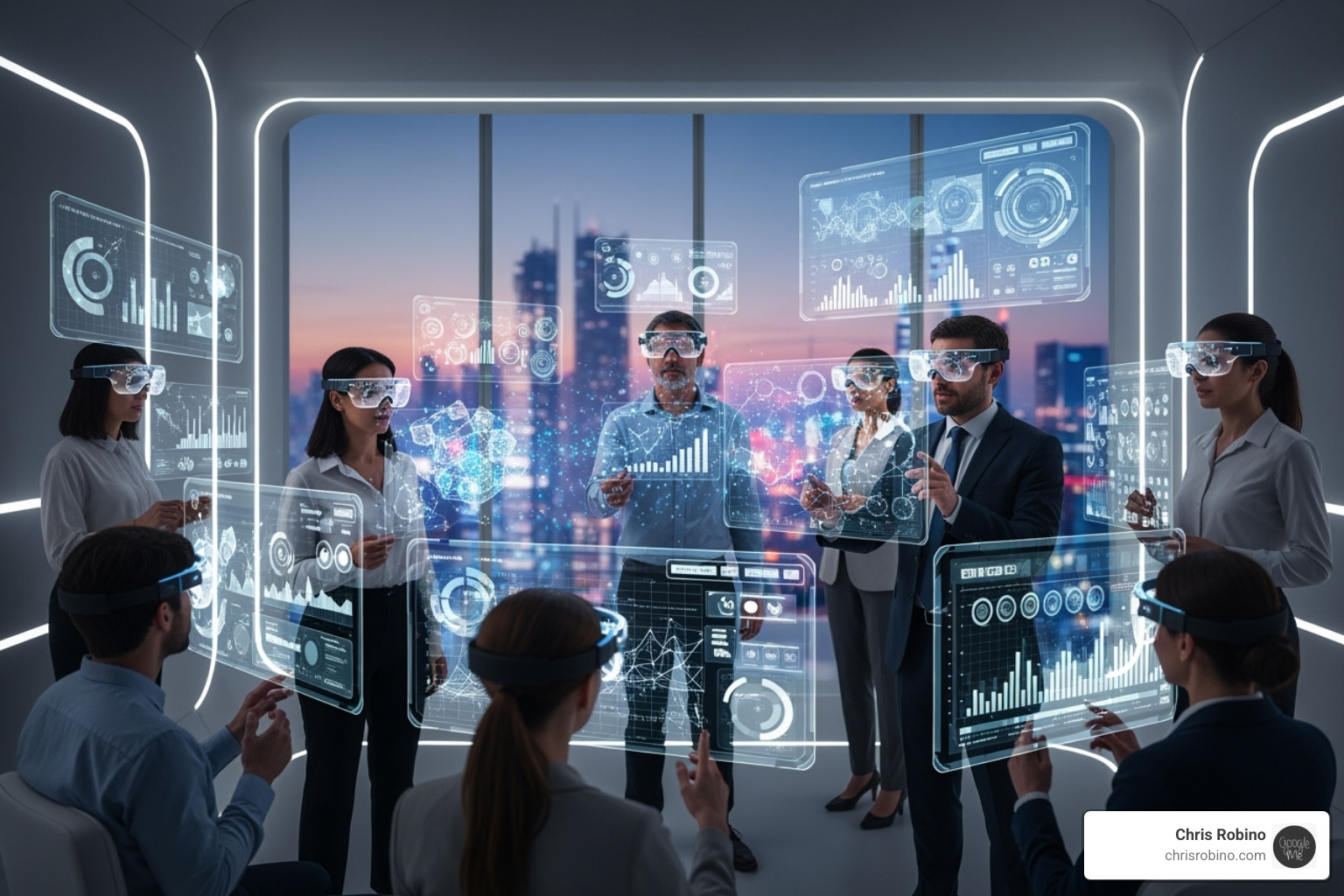
The Future of Communication: What’s Next and How to Prepare
As exciting as the present is, the Future of communication holds even more profound changes. We’re on the cusp of advancements that will challenge our understanding of connection.
On the Horizon: The Future of Communication with Brain-Computer Interfaces
In the more distant future, we may communicate by sending thoughts through a network directly into someone else’s brain. While still decades away, scientists are creating brain-computer interfaces (BCIs) that allow people to transmit thoughts directly to a computer. The possibilities include instant knowledge transfer, direct emotional sharing, or even electronic telepathy. The science behind BCIs reveals the immense effort involved in this field. This is where science fiction begins to merge with reality. As an Emerging Technology Consultant, we closely monitor these groundbreaking developments.
Alongside BCIs, AI-driven networks are becoming mainstream, focusing on creating transformative applications. This includes holographic communications, where 3D projections of individuals could interact in real-time, making remote meetings feel truly present. Immersive virtual reality (VR) experiences will also become commonplace, offering fully simulated environments for communication and collaboration.
To support these bandwidth-intensive applications, network infrastructure must evolve rapidly. By 2025, the initial commercial deployment of 50G PON technology is expected, signaling a significant capacity increase for homes and enterprises. This new generation of passive optical networks will be crucial for delivering the ultra-fast, low-latency connections required for the next wave of communication technologies.
Navigating the Ethical Landscape of AI-Powered Communication
With great technological power comes great responsibility. As AI becomes deeply embedded in our communication, it introduces significant ethical concerns that we must address proactively.
First, we must remember the irreplaceable role of human connection. Effective communication relies on empathy, understanding, and shared experiences. AI cannot replicate the nuances of human interaction or the depth of genuine connection. Over-reliance on AI could lead to social isolation or a diminishment of our interpersonal skills.
A major concern is AI bias. If training data contains societal biases, AI systems can perpetuate and amplify these discriminatory practices. This could lead to unfair treatment or the exclusion of certain groups. We need robust ethical frameworks for AI development to ensure fairness, accountability, and transparency. This is why we advocate for More info on honoring character in tech in all our projects.
Data privacy is another critical issue. Augmented reality systems could overlay digital information onto real-world views, raising significant privacy concerns about what data is collected, how it’s used, and who has access to it.
The rise of AI also challenges trust and truth. 70% of news publishers worldwide fear that AI will weaken trust in news. With AI-generated content and deepfakes, distinguishing between authentic and artificial communication becomes difficult. This necessitates greater transparency in AI usage, with the public demanding clear disclosure when AI is involved. Journalists, for instance, expect transparent disclosure of AI’s role in newsrooms.
Navigating this ethical landscape requires a careful balance between leveraging AI’s power and safeguarding our human values.
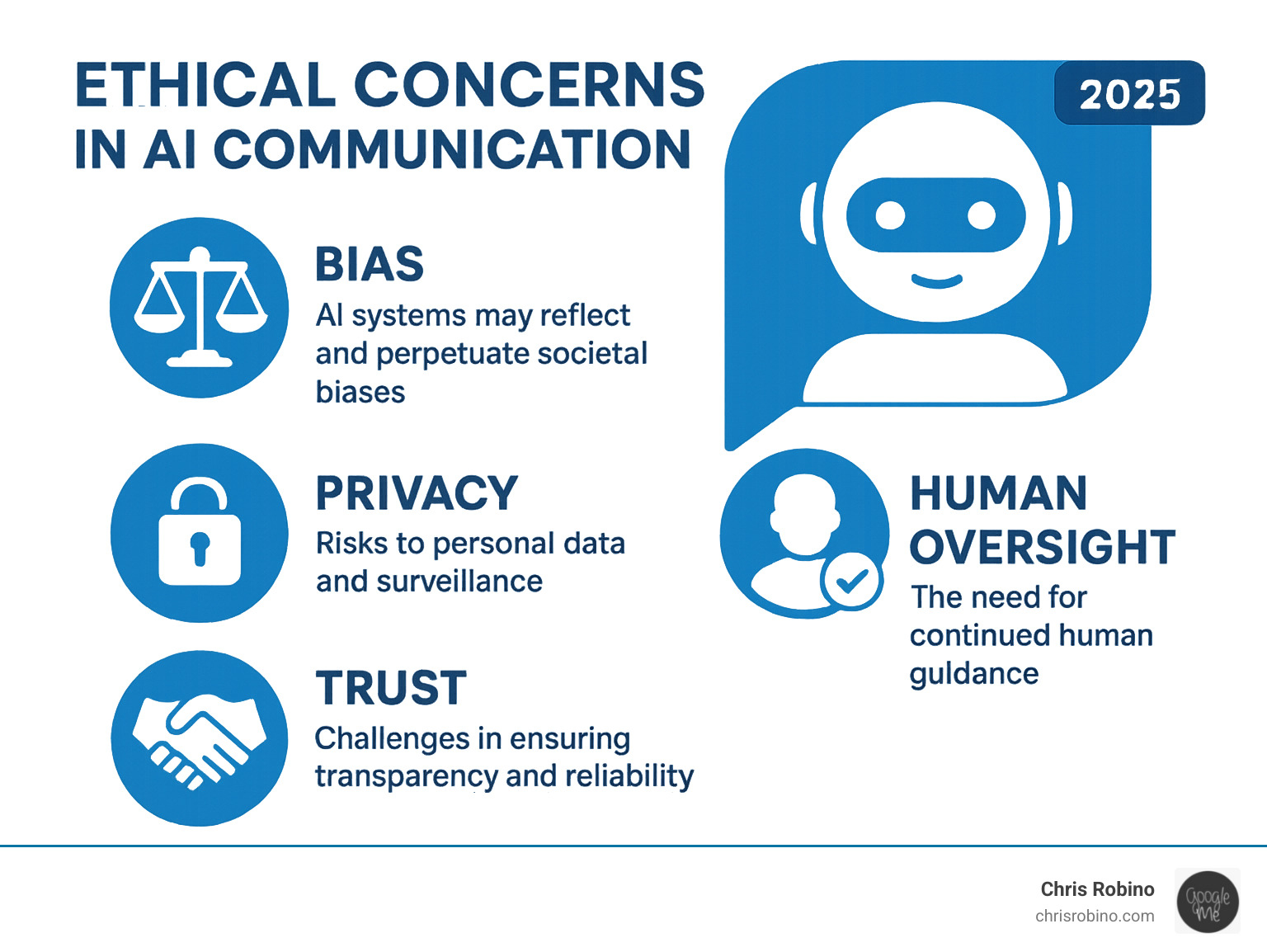
Strategizing for Tomorrow’s Communication Challenges
The future of business communication is about creating seamless, intelligent interactions that improve employee productivity and customer experience. To thrive, businesses must adopt a proactive, strategic approach.
Start by assessing your current communication infrastructure to identify strengths and technology gaps. This involves a thorough audit of current systems, from internal collaboration tools to customer-facing platforms.
Next, develop clear implementation roadmaps. This means identifying priority areas for upgrade, setting realistic timelines, and planning the integration of new technologies like AI and IoT. It’s about strategically integrating new tech into existing ecosystems.
Employee training is paramount. New technologies are only as effective as the people using them. Investing in comprehensive training ensures teams are proficient with new communication tools, fostering adoption and maximizing ROI.
Strategic investment is key. This includes allocating resources for scalable platforms, robust security measures, and continuous infrastructure upgrades. Companies that accept these emerging technologies will be better positioned for success.
An agile mindset is crucial. The communication landscape will continue to evolve, so strategies must be flexible. We must continuously monitor trends, experiment with new approaches, and be ready to pivot.
Our expertise at Chris Robino lies in helping organizations steer these complexities. As a Digital Strategy Leader and AI Expert, we provide insights into leveraging emerging technologies and developing robust strategies for the Future of communication. We help businesses prepare for future trends, ensuring they remain competitive. Our comprehensive services, detailed in More info about how to Get To Work, are designed to guide you through this change.
By embracing these changes, addressing ethical concerns, and strategically preparing for the future, we can ensure that communication continues to be a force for connection, collaboration, and progress.
